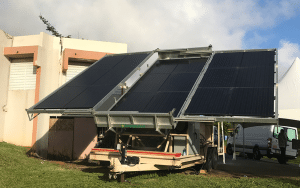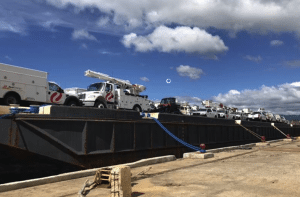More Utility Workers in Puerto Rico as Power Restoration Continues
U.S. utilities continue to send workers to Puerto Rico to help restore that country’s electricity and rebuild its power infrastructure, a task that continues more than four months after back-to-back hurricanes left nearly all of the island in the dark.
The Puerto Rican government this week said 83% of the island’s generation capacity has been restored, and about 70% of customers have power. Tom Lewis, president of U.S. operations for Louis Berger, a New Jersey-based global infrastructure engineering and development firm contracted by the U.S. Army Corps of Engineers (USACE) to work in Puerto Rico, told POWER in a January 31 interview that the capital San Juan “is about 90% back.”
Lewis said Louis Berger has “873 people [in Puerto Rico] right now, and at the height we probably had 1,100 or so working there. It’s a mix of Louis Berger folks, subcontractors, and what we call 1099s—independent contractors. There’s a whole cadre of these people who follow disasters and help with restoration.”
The Federal Emergency Management Agency (FEMA) today said it would continue to provide food and water to Puerto Rico, reversing course one day after a spokesperson said that aid would end on January 31, and the remaining supplies on the island would be turned over to the Puerto Rican government for distribution. U.S. lawmakers from both parties on January 30 reacted angrily to that statement; the Puerto Rican government said it was not aware of any plan to end FEMA’s involvement.
FEMA’s public affairs director, William Booher, today said his agency is working on a transition, but said the January 31 date “was mistakenly provided.” He added, however, that FEMA is confident that enough food and water is stockpiled on the island that the agency does not need to ship further supplies.
FEMA on Tuesday said it had distributed more than 65 million liters of bottled water, at a cost of more than $361 million, and had provided food worth at least $1.6 billion to the island. The agency said more than $259 million in financial aid had been provided to repair and rebuild homes, and for residents to rent housing.
Hurricane Maria hit Puerto Rico on September 20, 2017, just two weeks after Hurricane Irma hit the island as it roared across the Caribbean. The official death toll just from Maria stands at 64, though some officials say more than 1,000 people may have been killed by the storm, due to the difficulty of reaching some of the island’s remote areas.
A Mission with Different Roles
Lewis noted that some of Berger’s workers “were there before Irma, as part of an ADVON [advance on-site] mission, which is fairly uncommon. We placed people both in the U.S. Virgin Islands and Puerto Rico, and as soon as the storm moved away, they were assessing damage. Then came Maria, and our people had to hunker down and [find] shelter in place.”
Louis Berger has an $860 million contract with the USACE, and also is doing pro bono work in Puerto Rico. On January 26 it deployed pro bono a solar hybrid microgrid (Figure 1) in the rural mountain village of Barrio Nuevo, providing power to a children’s shelter and a shelter for women. It’s part of the company’s effort to show that renewable energy is a viable option for Puerto Rico today and in the future.

“I’ve made three trips [to Puerto Rico] since the hurricanes, and also had worked there previously,” said Lewis, who returned to New Jersey on January 27 after a five-day stint on the island. “Our headcount on any given day is very much a fluid thing. Typically, in disaster response and recovery, your people are working seven days a week, for 12 to 16 hours a day or more. A human being can’t keep that up, so we work on rotation. Depending on the [job] position, it can be as short as 30-day rotations, and no more than 90 days.”
“When it comes to the power [restoration] mission, we have a few different roles,” Lewis said. “Our primary role is [to] haul and install [diesel generators]. The federal government [FEMA] provides its own generators, and our haul and install mission is to take the generator from its origin, to where it needs to be for the user. The install part is the connection and troubleshooting, and on the back end is the de-install. That’s the core of our mission, probably two-thirds of the work we’re doing.”
Lewis said his group, which has helped in many areas with recovery from storms over the past several years, is installing more generators in Puerto Rico “by a factor of three. As of this morning [January 31], we have 917 generators operating in the field. We have a staging yard with several more generators waiting to be used. Our total installs on this mission so far is 1,524; that includes some generators that maybe were installed in one place, and when the power comes on there, [so the generator] is moved to another place.”
Lewis also said his group is “providing fueling to the generators we install, as well as other generators. We also do operations and maintenance of other generators, not installed by FEMA. That’s a new mission, something that has not been a part of our prior mission from the Army Corps of Engineers. In Puerto Rico, pretty much everyone has a [diesel] generator. It’s cheaper for the Army Corps and FEMA to let us troubleshoot and service other people’s generators.”
“Then there’s the microgrid mission, which is kind of a subset of the haul and install mission. Normally in the haul and install mission, we are directly connecting the generator to the user facility, the school, hospital, fire station. We keep it running until we take it away. This mission, because the central transmission and distribution system is in such disrepair, we’ve taken to installing large diesel generators to local substations. We did this on the island of Culebra,” he said. Culebra is a small island off the east coast of the main island of Puerto Rico.
“There’s a marine cable that connects Culebra to the main island,” Lewis said, noting the cable lost power when the main island lost power. “In Culebra, we put two, 2-MW diesel generators next to the substation, and connected them to the substation. It’s the first time the Army Corps has done that, connected to a substation that serves an entire community, rather than installing generators on a facility-by-facility basis.”
Fluor, Utilities Helping with Restoration and Repair
Texas-based Fluor Corp. also has large contracts for work in Puerto Rico. Its first task order was issued in October 2017; a second was issued in December 2017. The contract includes evaluation, restoration, repair, and replacement of structures and equipment supporting the island’s electrical infrastructure.
More than 20 U.S. utility companies have workers on the island; the Puerto Rico Electric Power Authority (PREPA) says more than 5,500 workers are currently part of restoration efforts. Minnesota-based Xcel Energy on January 29 sent more than 70 workers to Puerto Rico from Minneapolis; Denver, Colorado; and Lubbock and Amarillo, Texas. Xcel trucks earlier this month moved by barge (Figure 2) from Lake Charles, Louisiana, arriving in Puerto Rico on January 18.

“We want to assist the people of Puerto Rico and we are honored to be part of this restoration effort,” said Kent Larson, executive vice president and group president, operations, for Xcel, in a statement Monday. “This is a massive undertaking under difficult circumstances, but our crews are ready to bring power back on safely.”
Exelon Corp. on January 29 said workers from six of its utilities—PECO, Atlantic City Electric, Delmarva Power, Baltimore Gas & Electric, ComEd in Chicago, and Pepco in Washington, D.C.—also are headed to Puerto Rico. “Electricity is a vital part of life, and the residents of Puerto Rico have been without for so long,” PECO’s COO Mike Innocenzo said in a statement announcing the company was sending 16 lineworkers to the island.
Georgia-based Southern Company sent trucks, tools, and equipment on barges from Mobile, Alabama, on January 3; the shipments arrived in Puerto Rico on January 15. Southern also sent personnel from four of its operating companies—Mississippi Power, Georgia Power, Alabama Power, and Gulf Power—to the island this month, and said the workers are expected to be deployed for about 45 days, or until early March. Southern Company is among several investor-owned electric companies, all members of the Edison Electric Institute (EEI), that have deployed line crews to Puerto Rico.
EEI has said the costs that utilities incur in aid situations such as this are eligible for reimbursement from FEMA’s public-assistance program.
Storms’ Impact ‘In a League of its Own’
Lewis said the damage from Irma and Maria was akin to other storms, such as hurricanes Katrina and Ike, and Superstorm Sandy, “but this one’s impact is in a league of its own. It’s multiple times worse than anything we’ve ever seen. The transportation infrastructure, power infrastructure, a lot of it was just gone.”
He said coordination among agencies is key as the power restoration and rebuild continues. “FEMA is the boss, and the Army Corps implements the plan through Louis Berger” and other contractors, he said. “There are daily calls that involve FEMA, the Army Corps, and Louis Berger that determine where a generator goes.
“We have a separate mission than do the utilities, but we do have to coordinate at times,” Lewis said. “Like at Culebra, since we were connecting into a distribution system, we don’t want to energize a substation if some of the distribution lines downstream are not safe.”
Louis Berger’s continuing work also will include a second phase to its solar hybrid microgrid project, as the company wants to show the advantages of distributed power generation as opposed to relying solely on a centralized grid, particularly in storm-prone areas. The project is expected to continue until the central power grid in Puerto Rico is restored.
—Darrell Proctor is a POWER associate editor (@DarrellProctor1, @POWERmagazine)